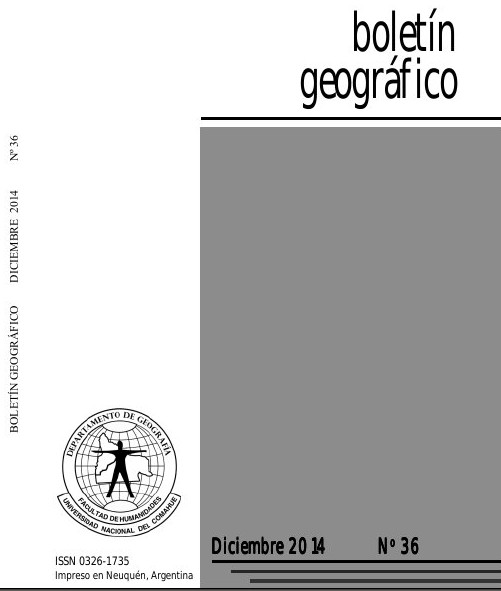Critical analysis of historical cartography of río negro valley.
Keywords:
territory, power, cartography, ideology, territorial configurationAbstract
Abstract
The maps contain different conceptualizations of geographic space, so is possible to say that maps implicitly express ideas, desires, perspectives and priorities on a given territory; and therefore constitute clear power tools.
The selection of the cartographic documents on which this analysis is sostained on the idea that each map holds a certain view of the territory, and also expresses the degree of development of mapping techniques used in each historical moment.
In production, reading and interpretation of mapping take place the ideological and sociocultural context in which both the cartographer and the reader are involved.
Thus, maps are never neutral, on the contrary, are a constructed reality, therefore confirmthat cartography represents the space, and also produces it.
Downloads
References
CAPDEVILLA, J.; HARLEY, J.B. (2002) The new nature of maps: essays in the history of cartography. Biblio 3W, Revista Bibliográfica de Geografía y Ciencias Sociales, Universidad de Barcelona, Vol. VII, Nº 404. pp. 7 http://www.ub.es/geocrit/b3w-404.htm. (Consulta: Abril de 2010)ISSN1138-9796.
CORTESE, V.; MEMBRIBE, A. (2008) Contribuciones Teórico-Metodológicas para el Análisis de la Producción Cartográfica. Boletín Geográfico 31. 353-365. Depto. de Geografía, Facultad de Humanidades, Universidad Nacional del
Comahue, Neuquén.
CRAMPTON, J. W.; KRYGIER, J. (2006) An Introduction to Critical Cartography.
ACME: An International E-Journal for Critical Geographies, 4 (1), (11-33).
DEHAIS, F.J. (2006) Contribuciones a la Cartografía de Patagonia o Chica entre 1519 y 1900. Gráfica Althabe. Neuquén.
DELGADO LÓPEZ, E. (2002) El mapa: importante medio de apoyo para la enseñanza de la historia. Revista Mexicana de Investigación Educativa. 7 (015) http://redalyc.uaemex.mx/redalyc/src/inicio/ArtPdfRed.jsp?iCve=14001507 (Consulta: Abril de 2010) pp. 340
EL PAIS DE LOS ARGENTINOS (1974) Argentina en el mapa. Revista N5. Centro Editor de América Latina. Bs. As.
HABEGGER, S.; MANCILA, J. (2006) El poder de la Cartografía Social en las prácticas contra hegemónicas o La Cartografía Social como estrategia para diagnosticar nuestro territorio. pp. 3
HARLEY, J. (2001) Hacia una deconstrucción del mapa. En: La nueva naturaleza de los mapas. Ensayos sobre la historia de la cartografía. Fondo de Cultura Económica, México.
JOLY, F. (1982) La Cartografía. Ed. Ariel. Barcelona.
LOIS, C. (2000) La elocuencia de los mapas: un enfoque semiológico para el análisis de cartografías. Documents d'analisigeografica, N. 36, págs. 93-109, http://ddd.uab.cat/record/1287
LOIS, C. (2004) Del desierto ignoto a territorio representado. Cartografía, Estado y Territorio en el Gran Chaco argentino (1866-1916).Cuadernos de Territorio 10. Instituto de Geografía. Facultad de Filosofía y Letras. Universidad de Buenos Aires. pp. 17
LOIS, C. (2009) Imagen cartográfica e imaginarios geográficos. Los lugares y las formas de los mapas en nuestra cultura visual. Scripta Nova. vol. XIII, núm. 298. Revista Electrónica de Geografía y Ciencias Sociales. Barcelona: Universidad de Barcelona, septiembre, http://www.ub.es/geocrit/sn/sn-298.htm
LÓPEZ, S.M. (2003) Representaciones de la Patagonia: colonos, científicos y políticos 1870-1914. Ed. Al Margen. Colección Universitaria. La Plata, Buenos Aires. Biblioteca Virtual de Ciencias Sociales de América Latina y El Caribe, de La Red de Centros Miembros de Clacso. pp.17
MAZZITELLI MASTRICCHIO, M.; LOIS, C. (2004) Pensar y representar el territorio: dispositivos legales que moldearon la representación oficial del territorio del Estado argentino en la primera mitad del siglo XX. 4º Congreso Virtual de
antropología. Mesa temática “Geopolítica y economía latinoamericana”. http://www.naya.org.ar/congreos2004/ponencias/carla_lois.doc. (Consulta: abril 2010). pp.5
MONTOYA ARANGO, V. (2007) El mapa de lo invisible. Silencios y gramática del poder de la cartografía. Universitas Humanística. 63. 165-167. Pontificia Universidad Javeriana. Bogotá, Colombia. http://redalyc.uaemex.mx. (Consulta:
abril 2010).
MONMONIER, M. (1996) How to lie with maps. The University of Chicago Press. Chicago
NAVARRO FLORIA, P. (2006) Paisajes del progreso. La Norpatagonia en el discurso científico y político argentino de fines del siglo XIX y principios del XX.. Scripta Nova. Vol. X, núm. 218 (76) pp. 1 Revista electrónica de Geografía y
Ciencias Sociales. Universidad de Barcelona. http://www.ub.es/geocrit/sn/sn-218-76.htm. (Consulta: abril 2010)
ROBINSON, A.; SALE, R.; MORRISON, J.; MUEHRCKE, P. (1987) Elementos de Cartografía. Ed. Omega. Barcelona.
QUINTEROS, S. (2000) Pensar los mapas. Notas para una discusión sobre los usos de la cartografía en la investigación social. En ESCOLAR, C. (Comp.) (2000) Topografías de la investigación. Métodos, espacios y prácticas profesionales. Ed. EUDEBA. Universidad Nacional de Buenos Aires.
QUINTERO PALACIOS, S. (1995) Geografía y Nación. Estrategias Educativas en la representación del territorio argentino (1862-1870). Territorio N° 7. Para la producción y crítica en Geografía y Ciencias sociales. Instituto de Geografía. Facultad de Filosofía y Letras, Universidad Nacional de Buenos Aires.
ZUSMAN, P.; MINVIELLE, S. (1995) Sociedades geográficas y delimitación del territorio en la construcción del Estado-Nación argentino. http://www.puentes.gov.ar/educar/superior/biblioteca_digital/disciplinas/verdocbd.js
p?Documento=110925www.educ.ar. (Consulta: abril 2010).
Downloads
Published
How to Cite
Issue
Section
License
Copyright (c) 2014 Boletin GeográficoTransfer of rights and data processing
The acceptance of an article for publication in the Journal Geographic Bulletin implies the cession of the rights of printing and reproduction, by any means and means, of the author in favor of the Department of Geography of the National University of Comahue, which will not reject any request reasonable for the authors to obtain permission to reproduce their contributions. The total or partial reproduction of the works published in the Geographic Bulletin must be done citing the origin, otherwise, the copyright is violated.
Likewise, it is understood that the concepts and opinions expressed in each work are the sole responsibility of the author, without being responsible or in solidarity, necessarily, neither the editorial staff nor the editorial staff.
It is the responsibility of the authors to be able to provide interested readers with copies of the raw data, procedure manuals, scores and, in general, relevant experimental material.
Likewise, the Management of the journal guarantees the appropriate treatment of personal data
COPYRIGHT TRANSFER FORM


















 Journal of the
Journal of the 